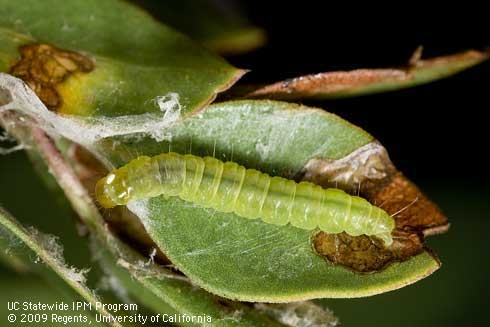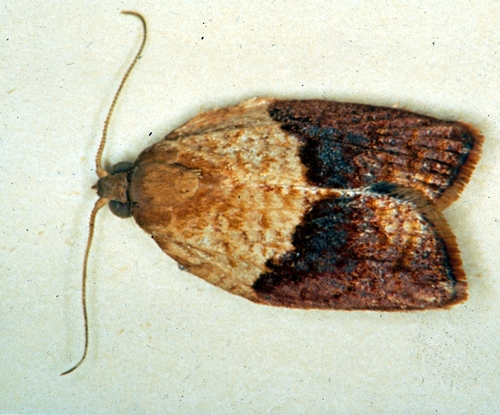Posts Tagged: light brown apple moth
The UC Statewide IPM Program provides new resources to help workers identify the light brown apple moth.
Nursery workers are our first line of defense in detecting light brown apple moth when growing ornamental plants in commercial nurseries. A new brochure and video can help those in the field distinguish light brown apple moth from several look-alike caterpillars.
Light brown apple moth is currently under a California Department of Food and Agriculture quarantine that regulates the interstate shipment of plants to keep the moth from spreading to new areas. It has been quarantined in various counties throughout coastal California ranging from Mendocino to San Diego.
Correct field identification of the light brown apple moth is the first step in containing the spread of this moth. Unfortunately several other leafroller caterpillars, including the orange tortrix, omnivorous leafroller, avocado leafroller, and apple pandemic moth, look similar to light brown apple moth caterpillars. This makes photo identification tools that can go into the field with workers, like the Field Identification Guide for Light Brown Apple Moth in California Nurseries, a useful resource for nursery workers.
The field guide was created by Steven Tjosvold, Neal Murray, University of California Cooperative Extension; Marc Epstein, Obediah Sage, California Department of Food and Agriculture; and Todd Gilligan, Colorado State University with the Statewide Integrated Pest Management Program (UC IPM).
An exotic and invasive pest from Australia, light brown apple moth has a host range of more than two thousand plants. It is a pest to a wide range of ornamental and agricultural crops, including caneberries, strawberries, citrus, stone fruit, apples, and grapes. The caterpillars eat leaves and buds, leading to weak or disfigured plants. They also can feed directly on fruit, causing the fruit to be unmarketable.
For more information on light brown apple moth and other leafrollers found in nurseries, see the UC Pest Management Guidelines for Floriculture and Nurseries.

Adult light brown apple moth.

Juvenile stage of the light brown apple moth.
LBAM--Not Your Typical Invader
The light brown apple moth (Epiphyas postvittana)--it's not your typical invader. UC Berkeley...

Female light brown apple moth, Epiphyas postvittana. (Photo courtesy of David Williams, principal scientist, Perennial Horticulture, Department of Primary Industries, Victoria, Australia.)

Male light brown apple moth, Epiphyas postvittana. (Photo courtesy of David Williams, principal scientist, Perennial Horticulture, Department of Primary Industries, Victoria, Australia.)
Medfly and Moth Wars
James R. Carey is used to dissent. The entomology professor at the University of California,...

James Carey

Light Brown Apple Moth
LBAM: What's the Status?
Remember the ravenous light brown apple moth (LBAM) and all the controversy? The invasive...

Male Light Brown Apple Moth

Female Light Brown Apple Moth
Good Question
Most entomologists I know maintain a keen sense of humor. They have to,...
William Roltsch